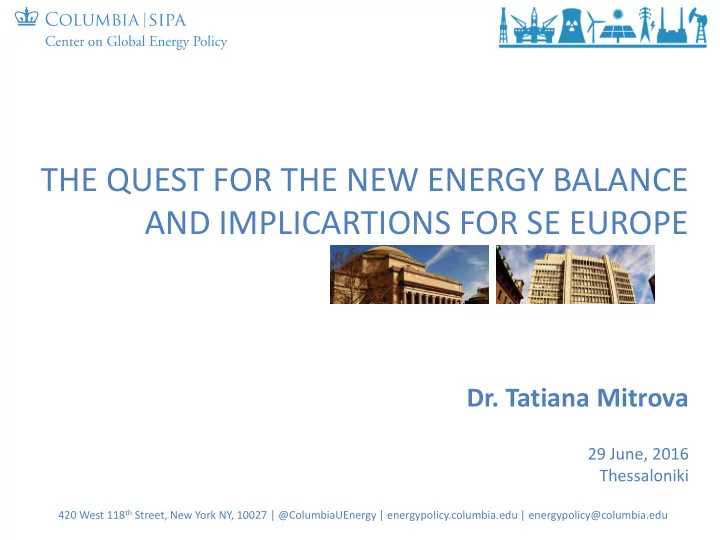

THE QUEST FOR THE NEW ENERGY BALANCE AND IMPLICARTIONS FOR SE EUROPE Dr. Tatiana Mitrova 29 June, 2016 Thessaloniki 420 West 118 th Street, New York NY, 10027 | @ColumbiaUEnergy | energypolicy.columbia.edu | energypolicy@columbia.edu
Global energy markets are undergoing profound trnasformation: key elements of uncertainty • Players strategies (cooperative or non-cooperative) • Geopolitics • Investment availability and speed (price elasticity of supply ) • Costs dynamics (learning curves, new technologies, currencies and exchange rates, cost deflation due to the competition between subcontractors, “sweet spots” depletion, development of the drilled but non -fracked wells) • Policies on taxation and access to the subsoil in the producing states • Global economic performance and demand prices elasticity EVERYBODY AGREE, THAT THE PRICES WILL GO UP AT A CERTAIN POINT, BUT NOBODY KNOWS WHERE EXACTLY THIS POINT WILL BE 2
In two decades the number of big oil producers (over 4 mb/d) will double, and the number of big gas producers (over 100 bcma) will increase 3 times Source: WEO2015, IEA 3
Changing global energy landscape: the number of oil and gas exporting countries is increasing, so the international markets are becoming more competitive than ever Main exporters of crude oil Main exporters of dry natural gas in 1990 and 2012 (KBPD) in 1990 and 2013 (BCF) Nigeria Malaysia 100% 100% Indonesia Libya Burma (Myanmar) 90% 90% Brunei Angola Australia 80% 80% Nigeria Algeria Algeria 70% Yemen United Arab 70% Qatar Emirates Saudi Arabia Oman 60% 60% Iran Qatar Uzbekistan 50% 50% Turkmenistan Oman Russia 40% 40% Kazakhstan Kuwait Former U.S.S.R. Azerbaijan 30% 30% Iraq United Kingdom Norway Iran 20% 20% Netherlands Russia Germany 10% 10% Trinidad and Tobago Kazakhstan Bolivia 0% 0% United States Azerbaijan 1990 2012 1990 2013 Canada Source: IEA 2016 4
Changing global energy landscape: “repartition” of the shrinking niches in the buyers` market and changing energy flows Russia Europe North Caspian America MENA Asia East Brazil Africa Australia 5 6
Consequences for SE Europe • Increasing supply availability and growing competition between suppliers • Lower hydrocarbon prices • Good opportunity to change the current fuel mix with strong oil and coal dominance and minor share of gas • Infrastructure and clear rules of the game are the key; development of a liquid gas hub is the only way to limit gas prices in the longer term • At the same time this cyclical oversupply could work in a negative way, allowing the governments to relax about supply security and energy efficiency issues • Diversification (of the fuel mix, supply sources and routes) is the most efficient way to ensure energy security 6
For more information contact Dr. Tatiana Mitrova Email: tm2845@columbia.edu
Recommend
More recommend